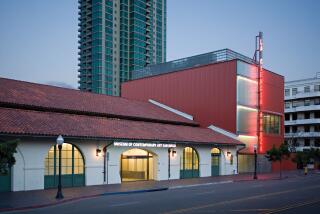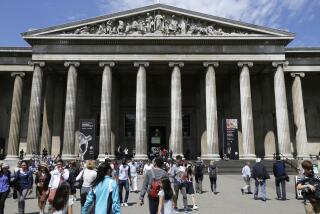Baltimore Museum of Art cancels the sale of a Warhol and two other paintings
Three important paintings, by Andy Warhol, Brice Marden and Clyfford Still, were pulled from the auction block Wednesday when the Baltimore Museum of Art reversed its plans — a decision made just hours before two works were to go on sale.
The museum had planned for a private sale of Warhol’s 1986 “The Last Supper” and a Wednesday evening auction at Sotheby’s of Marden’s 1987-88 “3” and Still’s “1957-G,” expected to raise a total of about $65 million or more. The sale generated much controversy, including a rebuke from Times art critic Christopher Knight, who criticized the museum deaccessioning trend and on Oct. 19 called Baltimore “the leading poster child for art collection carelessness.”
“If the sell-off to fund operations sets a precedent for other art museums,” Knight wrote, “the public loss will be immense.”
Pressure on the BMA mounted this week after former board chairmen Charles Newhall and Stiles Colwill said they were withdrawing pledges to the museum totaling $50 million, and two artists — Amy Sherald and Adam Pendleton — resigned as BMA trustees. Those moves came after supporters of the BMA, including community members and former trustees, sent a letter to Maryland Atty. Gen. Brian Frosh and Secretary of State John C. Wobensmith demanding that the sale be stopped.
Museum spokeswoman Anne Mannix Brown said Wednesday that the Newhall and Colwill pledges were merely oral pledges, which had not been officially recorded as gifts and were not part of the museum’s current budget.
“We would not expect two individuals who have so strongly stated their displeasure and disdain for the BMA’s vision to give to the museum,” she said. “However, this is not evidence that donors are rescinding gifts to the museum.”
The spokeswoman also suggested that Sherald and Pendleton resigned because of other commitments. “We are grateful for the time they invested and for the perspectives and ideas that they brought to the BMA,” she said. (The Times has reached out to representatives for both artists but has not yet received comment.)
The sale of the three paintings was supposed to generate income for the BMA’s Endowment for the Future program promoting diversity and equity at the museum. The money was to go toward initiatives including free admission, as well as salary increases for staff and purchase of works by female artists and artists of color.
The plan was announced after the Assn. of Art Museum Directors in April loosened its restrictions for deaccessioning for two years — an attempt to offer financially struggling museums a lifeline during the pandemic, not to encourage institutions to sell off art to pay for general operating expenses.
The BMA, which has a $20-million annual operating budget, has not instituted layoffs or furloughs during the pandemic.
The decision to call off the sale came after the association sent a memo to its more than 220 members clarifying the intent of the loosened restrictions. Association leaders also talked by phone with Baltimore museum officials, including director Christopher Bedford.
“I recognize that many of our institutions have long-term needs — or ambitious goals — that could be supported, in part, by taking advantage of these resolutions to sell art,” association board President Brent Benjamin said in the memo. “But however serious those long-term needs or meritorious those goals, the current position of AAMD is that the funds for those must not come from the sale of deaccessioned art.”
In a statement Wednesday, Benjamin emphasized that the rule changes were meant to address pandemic-related financial challenges, and “art collections should not be monetized except in very narrow and limited circumstances.”
The BMA responded Wednesday by saying the museum directors association had “affirmed” the museum’s plans “in private and public statements” this fall prior to BMA announcing the sale of the artworks on Oct. 2.
The BMA also argued that 2020 has been a year requiring “great fortitude and great questioning,” and that changes within the museum field are “right and just.”
“Our vision and our goals have not changed,” the museum said. “It will take us longer to achieve them, but we will do so through all means at our disposal. That is our mission and we stand behind it.”
More to Read
The biggest entertainment stories
Get our big stories about Hollywood, film, television, music, arts, culture and more right in your inbox as soon as they publish.
You may occasionally receive promotional content from the Los Angeles Times.










